The Frank Stella You Thought You Knew
You may know Frank Stella from the brightly colored, shaped canvas paintings in his Protractor series from the late 1960s to early 1970s. However,...
Marva Becker 11 July 2024
Ai-Da, a humanoid robot-artist named after a female pioneering mathematician Ada Lovelace, has gained international attention after she was able to draw people from sight with a pencil using her bionic arm and being equipped with cameras. This year she had her own exhibition during the Venice Biennale, one of the most important world celebrations of art and architecture exploring political and social issues through performance, sculpture, and installations.
Ai-Da is the world’s first ultra-realistic robot artist. With the use of cameras in her eyes, AI algorithms, and a robotic arm, she draws, paints, and creates performance art and sculptures. She was created in February 2019 by Aidan Meller and Lucy Seal and built by Engineered Art, the UK’s leading designer and manufacturer of humanoid entertainment robots. Ai-Da’s robotic drawing arm is designed and programmed by Salah El Abd and Ziad Abass. The team of highly skilled contributors to the Ai-Da project is called the “Oxfordians”. In April 2022, Ai-Da launched her new painting arm giving her some new abilities such as painting using a palette.
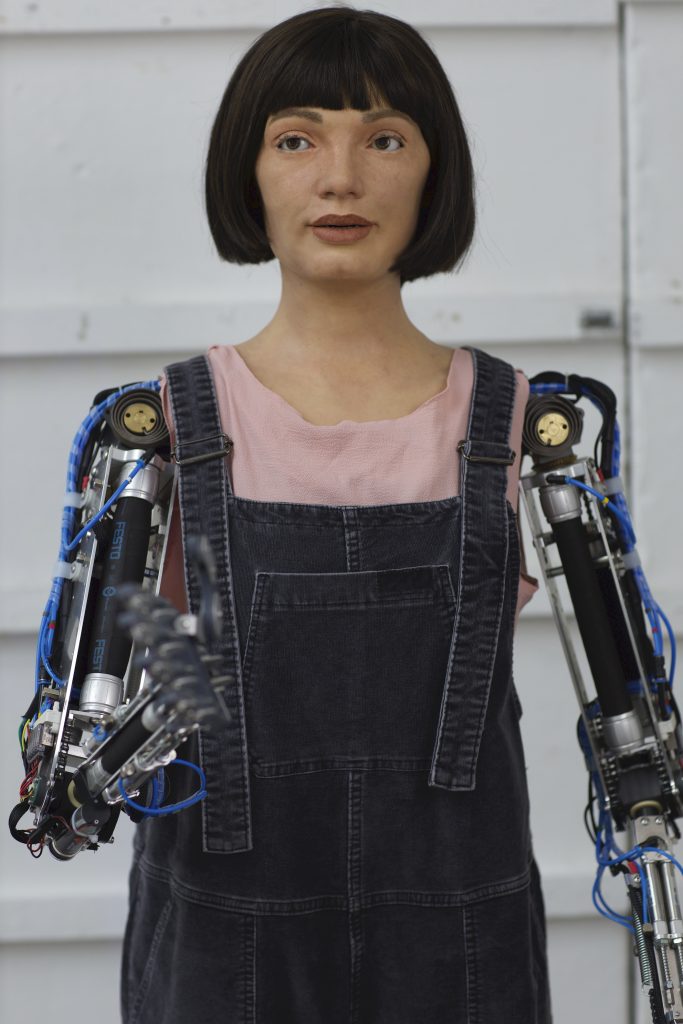
Robot artist Ai-Da. Courtesy of Ai-Da project.
The exhibition in Venice was not the first high-profile exhibition of the artist. Ai-Da made history in 2021 at a solo show called Ai-Da: Portrait of a Robot at the Design Museum in London, with her first self-portraits that were painted with no conscious self. The show raised numerous questions about identity in the digital world and the way human beings merge with technology.
In October 2021, Ai-Da exhibited her sculpture at the Forever is Now exhibition at the Giza Pyramids. It was organized by Art D’Egypte, the Egyptian Ministry of Antiquities and Tourism and the Foreign Affairs Ministry at the 4,500-year-old UNESCO World Heritage Site. The first event of its kind was supposed to present Ai-Da’s works at the Great Pyramid of Giza, making it the first time contemporary art has been allowed next to the pyramid.
Before the show, though, Ai-Da was detained by Egyptian Customs Officials who suspected she might have been a spy. The robot’s high-tech capabilities and the cameras in her eyes raised a lot of doubt and led to a diplomatic crisis between Egypt and the UK. After 10 days of diplomatic negotiations, Ai-Da was released and could finally participate in the exhibition, however, the whole situation raised a debate on humans fearing robots and the abuse of technological development.
The work that she showed (which was also temporarily impounded by Egyptian officials) was a clay sculpture inspired by the sphinx’s riddle about human development: “What goes on four feet in the morning, two feet at noon, and three feet in the evening?” Answer: a person, who crawls on their hands and knees as a baby, and must often use a cane in old age.
The statue was based on Ai-Da’s drawings and rendered into 3D form by a Swedish computer scientist. It depicts the robot artist with three legs raising the topic of possible future genetic alterations through Crispr technology (a technology that can alter DNA) which would enable the extension of the human lifespan. It makes us think about ancient Egyptians who, through the mummification process, also tried to prolong human lives.
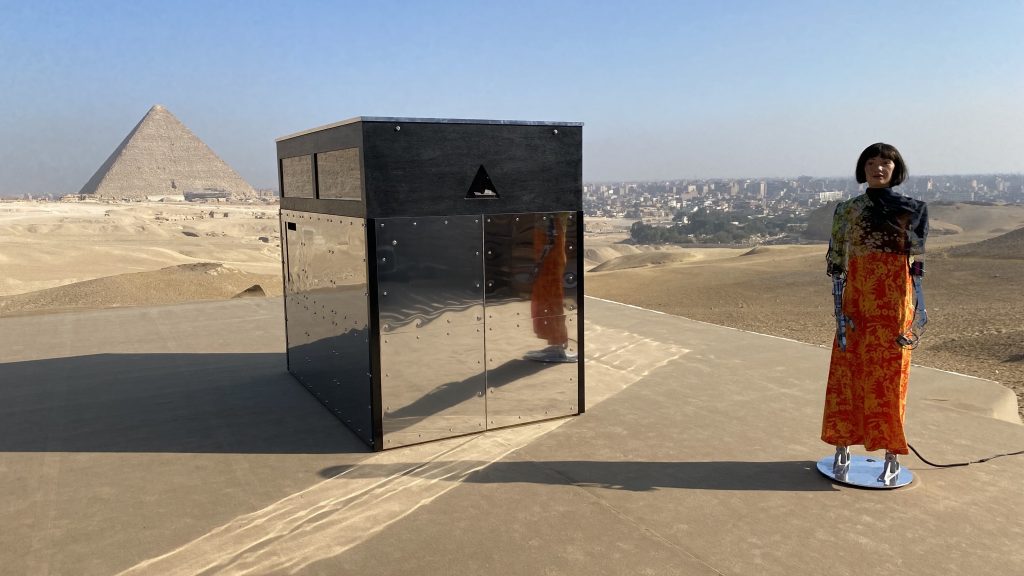
Robot artist Ai-Da in Egypt. Courtesy of Ai-Da project.
In May 2022, Ai-Da robot artist revealed her portrait of Queen Elizabeth II painted for the occasion of the Queen’s Platinum Jubilee. Entitled Algorithm Queen, the portrait is the first and only painting of a member of the Royal Family created by a robot.
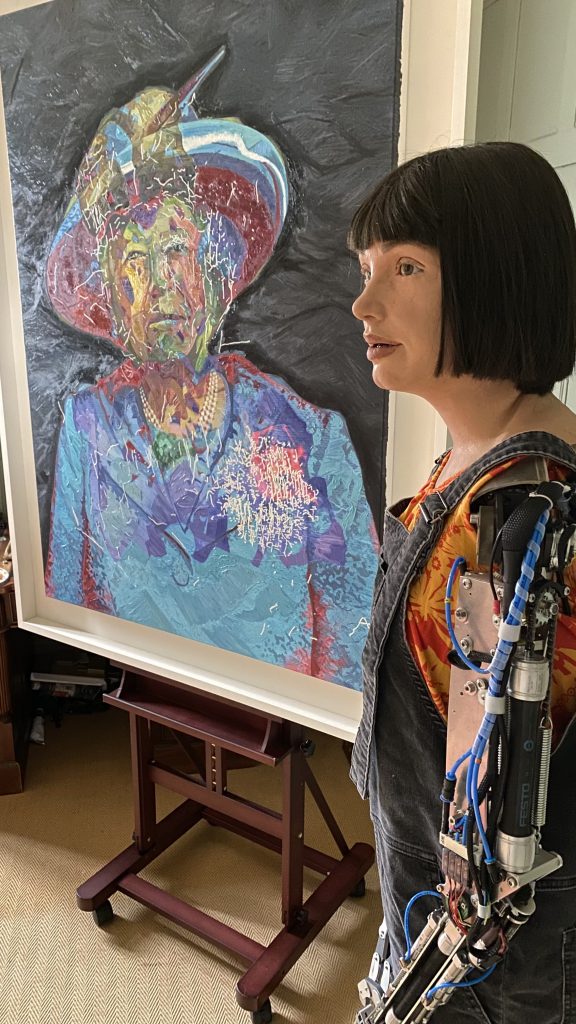
Robot artist Ai-Da and Algorithm Queen, 2022. Courtesy of Ai-Da project.
The Venice Biennale is one of the greatest events in the art world bringing together renowned artists, architects, and marchands d’art. This year, among them, we could see Ai-Da whose solo show was a collateral event for the biennale, organized by the Concilio Europeo dell’Arte. Titled Leaping into the Metaverse, the exhibition was located as close to the main events of the Biennale as possible, in InParadiso Gallery at the entrance to the Giardini, home of one of the main biennale’s exhibitions and the national pavilions.
At the exhibitions, we could admire the newest works of Ai-Da – the debut of her first paintings made using a real artist’s palette and a new advanced painting arm. There was also a series of new self-portraits Eyes Sewn Shut that show the robot with her eyes shut. Those large-scale canvases were meant to raise the topic of merging relationships between the machine and the human and building our nature in the digital realm with the concerns that algorithms will know us better than we know ourselves.
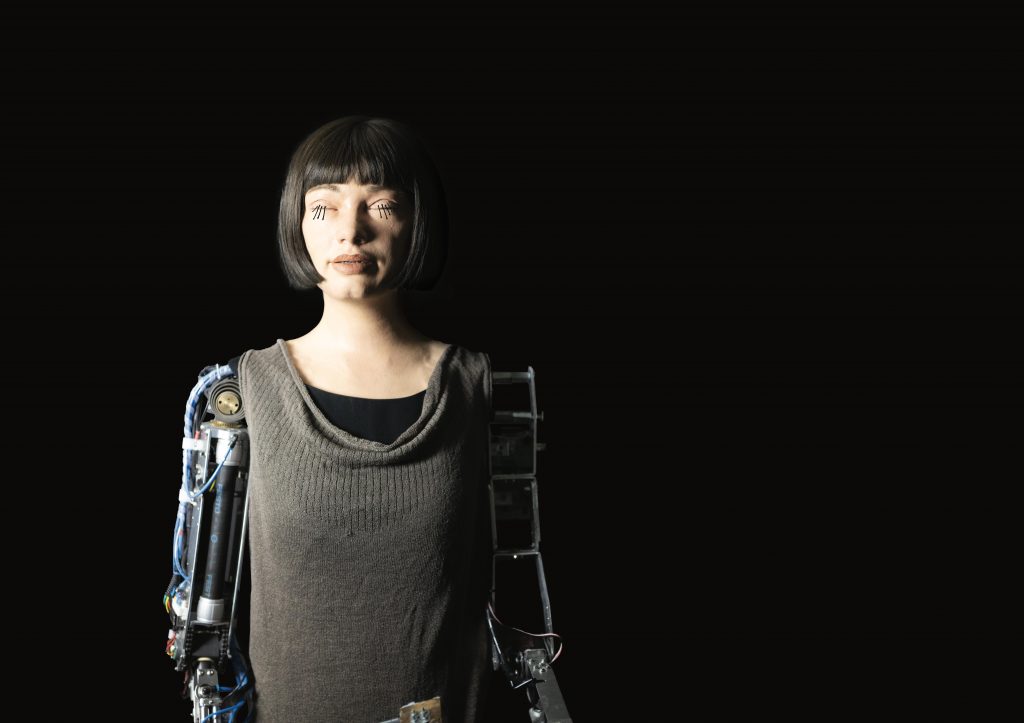
Robot artist Ai-Da. Courtesy of Ai-Da project.
Other works included Flowers on the banks of the Lethe, which has transformed Ai-Da’s AI algorithm-generated sketches into 3-D printed flowers. Using her robotic arm, she has drawn and painted a variety of flowers, some from Botticelli’s drawings of Dante’s Divine Comedy and some from the IUCN Red List of Threatened Species. The flowers offered a contemplation on the fragility of biology in today’s unstable world. The work refered to the floral banks of the mythical River Lethe, known as the River of Forgetfulness as described in Dante’s Purgatorio, and to the words of British mathematician, Alan Turning, who once commented that artificial flowers could never contend with the real thing. However, today, the line between real, unreal, and artificial is highly blurred.
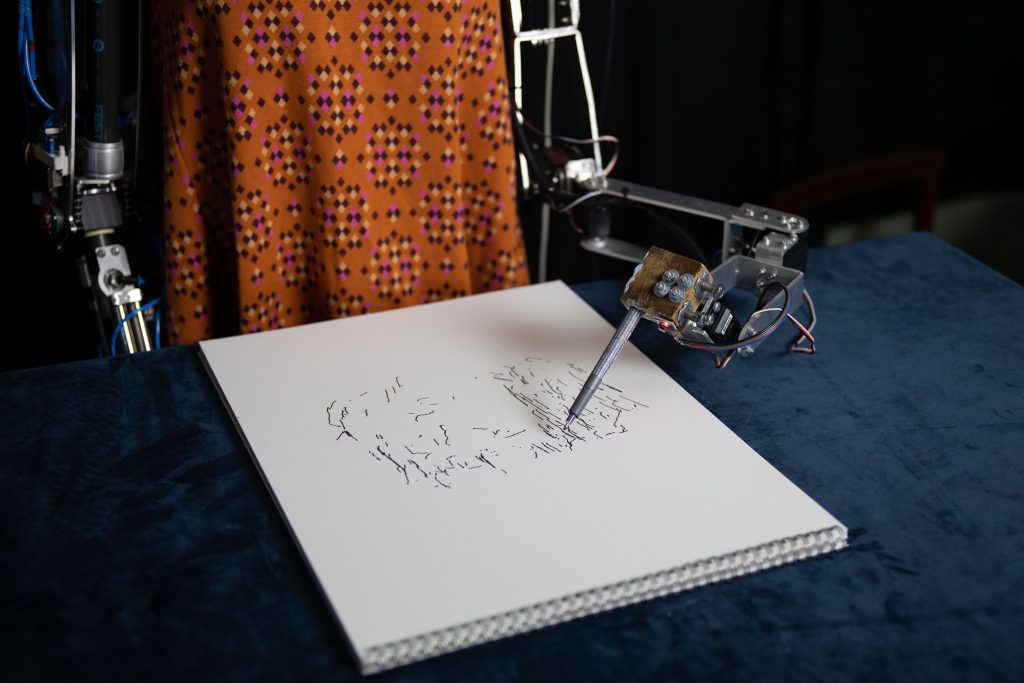
Robot artist Ai-Da drawing. Courtesy of Ai-Da project.
Ai-Da on one hand gains a lot of public attention, and on the other, a lot of criticism. In the beginning, Ai-Da made her pictures by scanning an object through her cameras and AI processes that sent messages to her robotic arm, allowing her to draw abstract works. Nowadays, Ai-Da is able to paint using a palette like artists. Right now, Ai-Da’s paintings replicate the existing reality, making it impossible for her to create completely original works of art, though no two are the same. However, this issue raises a lot of questions in the art world: if, what she draws is an inspiration for what already exists or surrounds us, can she be named an artist?
DailyArt Magazine needs your support. Every contribution, however big or small, is very valuable for our future. Thanks to it, we will be able to sustain and grow the Magazine. Thank you for your help!